So what should a perfect garden look like? Is it the sweeping lawns and grand trees of a landscape? Is it the health and perfection of each plant and soil to be marveled at? Is it the array and colour of the beds with a huge variety of flowers squeezed in miraculously? Is it the austerity of shape as in Andy Sturgeon’s Chelsea garden this year, or the romance and power of Versailles with its formal beds and fountains to play in, controlling nature at every turn. I think a perfect garden is all of these. It should make you dream, revel and lose yourself in the foliage and space as ones senses are captivated by the story of the place. A good garden should take you on an adventure irrespective of size. Such a garden is the wonderful, romantic Millgate Gardens in Richmond, North Yorkshire; an amuse-bouche of delight. 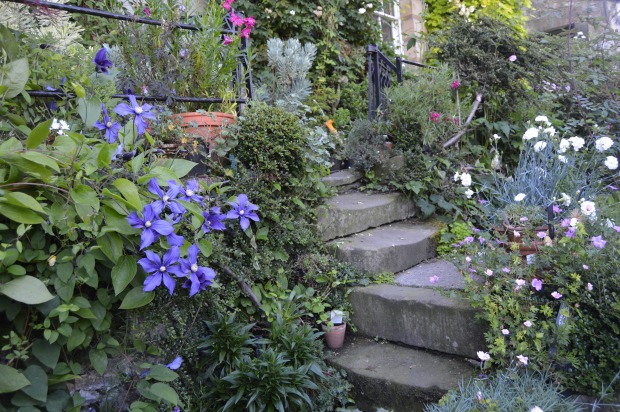
Just off the bustling market square of Richmond Town, a small dark Yorkshire snicket leads to a shadowed space on a slope overlooking the rooftops of the town down to the River Swale. Tim and Austin have an eye though; they must have seen in early 1980 the beautiful bone structures of a ravaged face of history.  A town house built in the 1650s and aggrandized by the Georgians. An outdoor space with steps and pathways descending down a few levels so that the owners can turn and look up the beauty of the one of the town’s houses, Millgate House, with its wrought iron railings and balance of tall elegant windows. Or turn and see the views across the walls or wait until the garden ends in the coach house at the bottom.
A town house built in the 1650s and aggrandized by the Georgians. An outdoor space with steps and pathways descending down a few levels so that the owners can turn and look up the beauty of the one of the town’s houses, Millgate House, with its wrought iron railings and balance of tall elegant windows. Or turn and see the views across the walls or wait until the garden ends in the coach house at the bottom.
They have used these beautiful bones to create a rose garden of such romance and fancy that you lose yourself in its flowery arbours. The simple colour scheme of shades of pink and shades of blue are created by a careful blend of roses and clematis under planted with simple cottage plants and laced with spires of Adenophera, Ladybells in whites and blues.
The simple colour scheme of shades of pink and shades of blue are created by a careful blend of roses and clematis under planted with simple cottage plants and laced with spires of Adenophera, Ladybells in whites and blues.
What could take ten minutes with your senses closed, took an hour as I lost my self under
Rosa Garland, laced through a tree with a blue clematis. I stood next to my favourite rose of the moment, the fluttering peach beauty of Lark Ascending, by David Austin, and looked out over the roof tops to the water below burbling down Swaldale.  For a few moments I saw myself not as a human but as a beautiful, natural rose arbour, entwined in pinks and blues and scented wonderfully. Who hasn’t wanted to be as beautiful as a rose? It was sublime until my group pulled me away.
For a few moments I saw myself not as a human but as a beautiful, natural rose arbour, entwined in pinks and blues and scented wonderfully. Who hasn’t wanted to be as beautiful as a rose? It was sublime until my group pulled me away.
The use of so many roses and clematis over the different descending levels have let Tim and Austin create more than just a garden. It reminds me of a stage set for romantic delight. Gentle Hermione, Gertrude Jekyll, the stripes old rose Ferdinand Pichard, Molineaux, Winchester Cathedral, all grow in corners or up pergolas, interlaced with Clematis such as the pale blue Prince Charles, or deeper blue Etoile Violette.
The garden has a style and form that belie any simplicity. The control and hard work can be seen not only in hidden delights of Albertine growing over a doorway into the snicket which grows harmoniously along side the clematis etoile violette.
These two plants are seen as the visitor comes out of a dark gloom of twisted trunks of a wonderful magnolia. It is the way the gardens have captured the light and dark of such moments that makes it so clever in its use of small spaces. Into the dark passage, an adventure of green foliage with hostas and ferns almost smothering the stone passage way. Yet when you turn and look up through another door way it is the golden hop that casts a golden invitation to investigate further through the arch.  Light and dark play also around the hoary sophisticated leaves and twisted trunk of Hydrangea sargentiana. It is these incidents that stop the garden being mere saccharine. The stone steps of grey and walls balance the green and shades of pink and the careful use of water allows what would be a dank garden to be filled with the charm of tinkling movement. Views are glimpsed, and wrought iron seats beckon invitingly to be sat on under shady covers.
Light and dark play also around the hoary sophisticated leaves and twisted trunk of Hydrangea sargentiana. It is these incidents that stop the garden being mere saccharine. The stone steps of grey and walls balance the green and shades of pink and the careful use of water allows what would be a dank garden to be filled with the charm of tinkling movement. Views are glimpsed, and wrought iron seats beckon invitingly to be sat on under shady covers.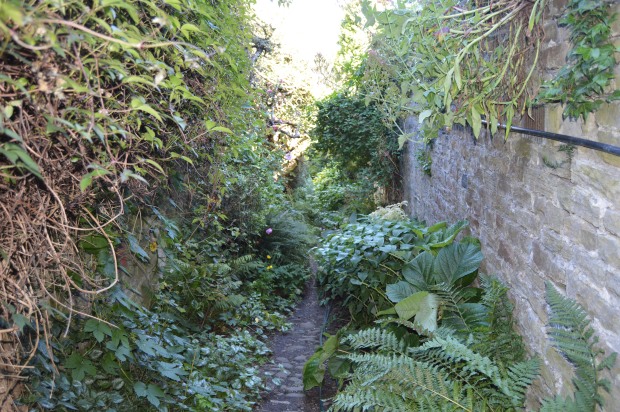
The plantings show not only roses and hostas but hint at the hydrangeas, the alliums and the greater use of structure and shade when the roses die down or are pruned. I am told the snow drops are a glory in their own right. But of course all of this works only because of Tim and Austin’s careful understanding of the space of their small garden, those beautiful bones that they found all those years ago. This garden has won the RHS garden of the year, and been mentioned as one of the best private gardens to visit by Allan Titmarsh. It’s B and B is also superlative. Come and be beguiled.
Just a note: the David Austin roses were perhaps struggling the most in the slightly darker and colder climes of Yorkshire. Beautiful as they are, when chillier than they like they are more prone to black spot and have less time to ripen to make their stems strong and shrub like. So roses, such as Constance Spry, are prone to droop, despite David Austin roses being bred explicitly for the shrubbery. At Millgate she is allowed to droop over a descending bed, while at my own garden not far away, I have been inspired to pick her off the ground and grow her up a pergola. Beautiful as they are David Austin roses need more heat and care and attention then perhaps people realise. Or he needs to breed a new range more suited to our colder Atlantic climate.

 The identification with the British nation’s beloved sweet peas is a genius attempt at being both down to earth, and still claiming the grandeur of a “Sweet Pea Week”. It is this careful balance of trying to attract the paying public to a memorable garden without shouting about it that makes Easton Wall an art form in marketing a modern garden for modern times.
The identification with the British nation’s beloved sweet peas is a genius attempt at being both down to earth, and still claiming the grandeur of a “Sweet Pea Week”. It is this careful balance of trying to attract the paying public to a memorable garden without shouting about it that makes Easton Wall an art form in marketing a modern garden for modern times.  The intimate spaces are balanced against the wider meadows and terraces of the old formal gardens. There are snow drop weeks, photography competitions, and the ubiquitous tea rooms and tasteful shop. Helpful notes point out that snowdrops will only be seen in the early year, should visitors need guidance, but the tea rooms are always open. The politics of running a garden are legion when they have to pay for themselves.
The intimate spaces are balanced against the wider meadows and terraces of the old formal gardens. There are snow drop weeks, photography competitions, and the ubiquitous tea rooms and tasteful shop. Helpful notes point out that snowdrops will only be seen in the early year, should visitors need guidance, but the tea rooms are always open. The politics of running a garden are legion when they have to pay for themselves. Innovative attempts at a Rose Meadow must be applauded although the bulbs are being swamped by overly strong grass, and the use of David Austin roses only was perhaps more for a marketing exercise than because they truly make the best roses for such an experiment. Black spot is a very real problem on some of the plants and David Austin roses are beautiful but do need more looking after than a wild meadow of grass interspersed with semi wild rose bushes habitat will give them.
Innovative attempts at a Rose Meadow must be applauded although the bulbs are being swamped by overly strong grass, and the use of David Austin roses only was perhaps more for a marketing exercise than because they truly make the best roses for such an experiment. Black spot is a very real problem on some of the plants and David Austin roses are beautiful but do need more looking after than a wild meadow of grass interspersed with semi wild rose bushes habitat will give them. The sweet peas themselves were well arranged. The small flowered historical varieties growing up individual towers and the cordons of more modern ones were lovely. From a gardeners perspective I couldn’t help notice that the soil looked a bit tired and lower yellowing leaves suggested a greater need to focus on plant health, rather like the roses. But with time and money always an object, I sympathise and identify with these problems that all of us have to manage. I will feed my own sweet peas more, a sea weed drench perhaps and mulch. One can never mulch too much.
The sweet peas themselves were well arranged. The small flowered historical varieties growing up individual towers and the cordons of more modern ones were lovely. From a gardeners perspective I couldn’t help notice that the soil looked a bit tired and lower yellowing leaves suggested a greater need to focus on plant health, rather like the roses. But with time and money always an object, I sympathise and identify with these problems that all of us have to manage. I will feed my own sweet peas more, a sea weed drench perhaps and mulch. One can never mulch too much.
 Supposedly a set of wild flower terraces in a formal setting. It doesn’t quite work. The hairiness of the grass is off balance with the formality of the steps and topiary domes. The domes themselves are over crowded and every other one now needs to be thinned and the whole aspect would do with better symmetry when looking back up to the site of the old house.
Supposedly a set of wild flower terraces in a formal setting. It doesn’t quite work. The hairiness of the grass is off balance with the formality of the steps and topiary domes. The domes themselves are over crowded and every other one now needs to be thinned and the whole aspect would do with better symmetry when looking back up to the site of the old house.
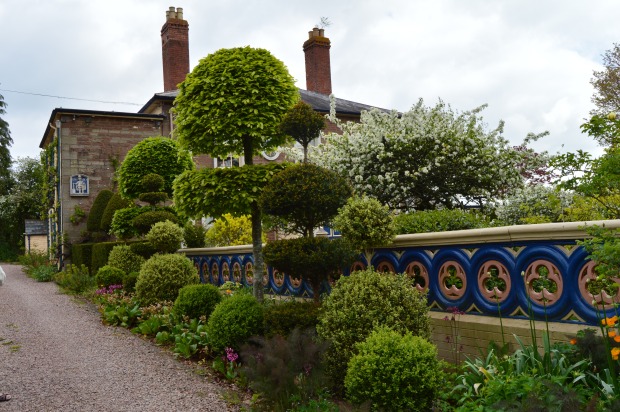

 Topiary balls, long walks, Italian Renaissance style, Greek temples, finials and twiddly bits and a memory of lots and lots of balls. Everywhere. The struggle and low pay of his early years is in evidence in some of the cheaper finishes and concrete slabs, as he proudly points out in his audio pack. It is a poverty that a lot of ordinary people share, but still want a Greek temple in their own gardens, or a raised bed, or a cloud pruned topiary box. The faults of the garden are clear, on the other hand it is packed full of the fun, the beautiful and the accessible, and gives us all permission to do what we want in our own gardens, despite the elitist horticultural fashionistas.
Topiary balls, long walks, Italian Renaissance style, Greek temples, finials and twiddly bits and a memory of lots and lots of balls. Everywhere. The struggle and low pay of his early years is in evidence in some of the cheaper finishes and concrete slabs, as he proudly points out in his audio pack. It is a poverty that a lot of ordinary people share, but still want a Greek temple in their own gardens, or a raised bed, or a cloud pruned topiary box. The faults of the garden are clear, on the other hand it is packed full of the fun, the beautiful and the accessible, and gives us all permission to do what we want in our own gardens, despite the elitist horticultural fashionistas.

 It is designed to be seen from the house so that Roy can look up to his wife’s memory from his front door. A charming idea full of tenderness to his wife, a bit clumsily executed in detail, with a Greek temple to suit any poolside in surrey. But not a garden designer’s solution. I do wonder how Julia would have felt about it.
It is designed to be seen from the house so that Roy can look up to his wife’s memory from his front door. A charming idea full of tenderness to his wife, a bit clumsily executed in detail, with a Greek temple to suit any poolside in surrey. But not a garden designer’s solution. I do wonder how Julia would have felt about it.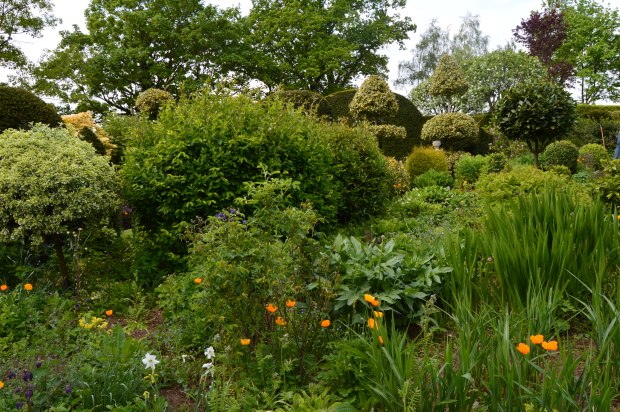
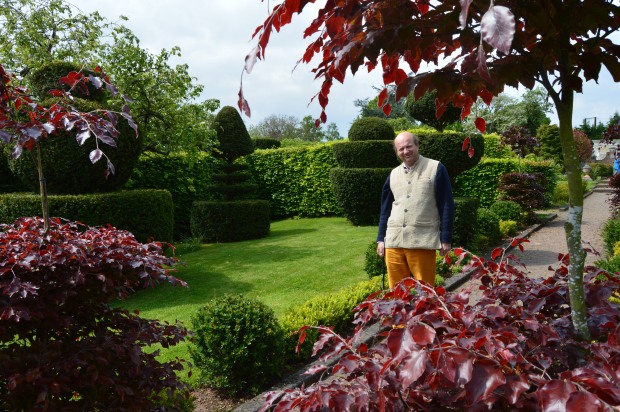
 A little valley of delights, a small light piece of humour. All shapes and structure with vistas and surprises. Painswick is a beautifully restored 18th century gardens of the short lived style, Roccoco. The sense of amusement lingers in the name, even as serious plant lovers will huff and puff at the nonsense of a valley given over to follies, avenues, trees and views. It is not a big place, but the orchard of immaculately pruned apple trees, standing in half an acre of wild meadow, and intersected with a long avenue up to the gothic folly of the red house on the hill were wonderful. We wandered above the valley, through the bluebell wood. Like alot of the such named places it is more romantically named than the reality as the bluebells struggled to grow in the mass that one hoped for. Perhaps it was all a recent plan, and the bulbs had not yet spread.
A little valley of delights, a small light piece of humour. All shapes and structure with vistas and surprises. Painswick is a beautifully restored 18th century gardens of the short lived style, Roccoco. The sense of amusement lingers in the name, even as serious plant lovers will huff and puff at the nonsense of a valley given over to follies, avenues, trees and views. It is not a big place, but the orchard of immaculately pruned apple trees, standing in half an acre of wild meadow, and intersected with a long avenue up to the gothic folly of the red house on the hill were wonderful. We wandered above the valley, through the bluebell wood. Like alot of the such named places it is more romantically named than the reality as the bluebells struggled to grow in the mass that one hoped for. Perhaps it was all a recent plan, and the bulbs had not yet spread. The rest of the valley is made up of a crown of white confection in the white gothic trellis at the top, sitting like a crown above a series of tulip beds and running down to the more serious apple espaliers which surround another half acre of vegetables, sitting in the manner of a grand French potager on the valley slopes, across from the orchard. The feet of the valley end in a muddy pool before the visitor can wander in the woods below on the wood chip tracks, invited to explore the nature trail. For those of us used to more rigorous country side, we declined, instead admiring the plunge pool and grotto to our left before heading for the pigonnier, the only building that was still extant before the restoration. As we walked round, not only glimpses of the lovely Painswick House could be seen sitting in splendour to one side of the valley, but the farms and houses of the neighbouring Gloucestershire houses were all to be included as joys of golden stone set in the valleys and hills beyond where the rolling countryside could join the vistas of the more formals amuse boufe (?) of the Roccoco gardens.
The rest of the valley is made up of a crown of white confection in the white gothic trellis at the top, sitting like a crown above a series of tulip beds and running down to the more serious apple espaliers which surround another half acre of vegetables, sitting in the manner of a grand French potager on the valley slopes, across from the orchard. The feet of the valley end in a muddy pool before the visitor can wander in the woods below on the wood chip tracks, invited to explore the nature trail. For those of us used to more rigorous country side, we declined, instead admiring the plunge pool and grotto to our left before heading for the pigonnier, the only building that was still extant before the restoration. As we walked round, not only glimpses of the lovely Painswick House could be seen sitting in splendour to one side of the valley, but the farms and houses of the neighbouring Gloucestershire houses were all to be included as joys of golden stone set in the valleys and hills beyond where the rolling countryside could join the vistas of the more formals amuse boufe (?) of the Roccoco gardens.